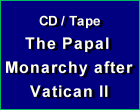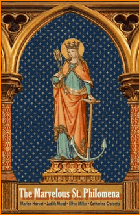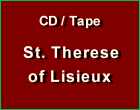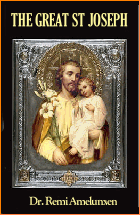Symbolism
 |
 |
 |
 |
 |
 |
 |
Arma Christi, the ‘Weapons of Christ’
or Instruments of His Passion
For the medieval man the symbol was a mark of identification. An emblem expressed a person, such as the winged lion who represents St. Mark, or a great event, such as a lily symbolizing the Annunciation. These symbolic representations have a simplicity, authenticity and sacrality that endure through the ages.
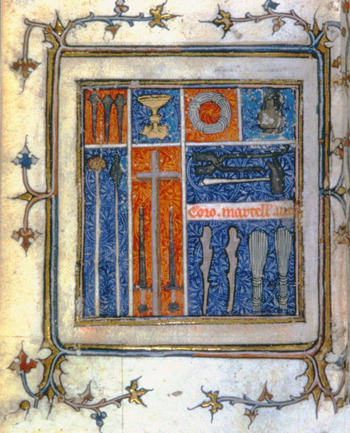 The reason for this? The medieval artist was imbued with the Catholic spirit; he believed that what he was painting or building represented an absolute. Consequently, what he created breathed his faith.
The reason for this? The medieval artist was imbued with the Catholic spirit; he believed that what he was painting or building represented an absolute. Consequently, what he created breathed his faith.
Certainly in the center of Catholic History is the Passion of Our Lord. Accordingly, symbols representing the Agony, the Betrayal, the Arrest, the Trial, the Condemnation, the Crucifixion, the Descent from the Cross and the Burial of Our Lord were very early used in painting and sculpture and universally recognized by the faithful.
Those symbols were given the beautiful name Arma Christi, or Weapons of Christ. They were the Instruments of the Passion, which in heraldry terms became the “arms” of Christ, for these were the weapons Christ used to achieve His conquest over Satan, death and sin.
Instruments of the Passion
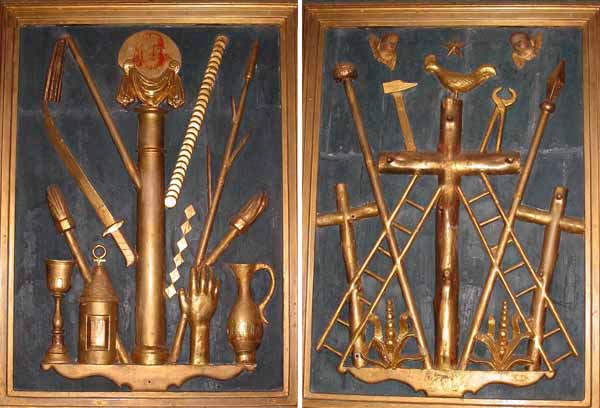
A sampling of the most important Passion symbols are set out very neatly in the two pictures above, from the 11th century Église Saint-Pierre in Collonges-la-Rouge. It seemed a good place to start for those interested in learning about the Arma Christi used in both Medieval and Renaissance illustrations and paintings. A recent resurgence of interest in symbols give such explanations special relevance today.
In this first picture above left, we find at at bottom left one of the best known symbols of the Agony, the chalice intended to evoke Christ's Agony in the Garden of Gethsemane. The chalice is called the Cross of Suffering, and is often pictured in manuscripts as a gold cup with precious jewels with a red Cross rising from it, symbolizing the Blood Our Lord sweat in the Garden.
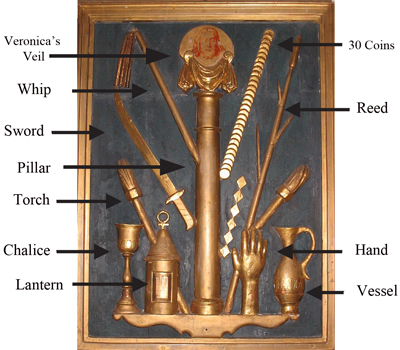 Next to it is the lantern and the torch of the Roman guards, symbols of betrayal. They refer to the scene in the Gospel of John (18:3) where Judas and band of ruffians "cometh thither with lanterns and torches and weapons."
Next to it is the lantern and the torch of the Roman guards, symbols of betrayal. They refer to the scene in the Gospel of John (18:3) where Judas and band of ruffians "cometh thither with lanterns and torches and weapons."
The sword and the rod – when crossed like the letter X – are also well-known symbols of the betrayal. The sword in this depiction of the Arma, however, is most probably the sword of St. Peter, used to sever the ear of Malchus, the servant of the high priest. Very often that severed ear is portrayed with the sword, indicating the Garden scene during Our Lord's arrest.
In the center we find the pillar or column, a key symbol of the trial and condemnation of Our Lord Jesus Christ. It reminds the faithful of the pillar where Our Lord was scourged on the order of Pontius Pilate. Atop the pillar is Veronica's veil, corresponding to the famous episode of Christ imprinting his Sacred Visage on the veil she offered Him as relief from His suffering. Still at the left of the column, we find a scourge (often two scourges in saltire are used) reminding us of His Scourging.
On either side of the Pillar, there is a rod or a reed to depict the mockery Our Savior suffered at the hands of His captors when they buffeted Him. Often a head spitting is painted to depict this offensive action of the brute executioners. The 30 coins of Judas are also displayed in a row here, stressing his iniquitous betrayal.
The vessel, at the bottom right, usually represents the water poured on Pilate’s hands.
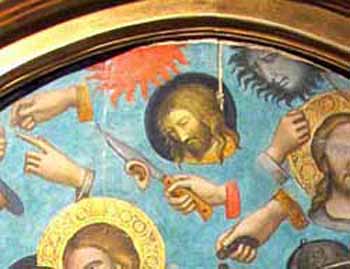 Finally, we find a hand, used to portray many scenes from the Passion. These severed hands scattered in the background of medieval crucifixion scenes like the one
at left can appear strange to the modern eye, but the medieval imagination understood how to interpret them.
Finally, we find a hand, used to portray many scenes from the Passion. These severed hands scattered in the background of medieval crucifixion scenes like the one
at left can appear strange to the modern eye, but the medieval imagination understood how to interpret them.
For example, in the picture at left, there are the many hands of the torturers of Christ (e.g. the clenched fist used to buffet Him, the pointing finger that mocks Him); then we have the hand of Peter cutting the ear of Malchus, the hand of the traitor Judas receiving the 30 coins from the hand of the high priest. Often in this kind of scenens are also the hands of Pilate washing them of the Blood of the Savior in a basin that spills the water. Sometimes a white towel used by Pilate to dry his hands is also pictured.
Another panel of symbols
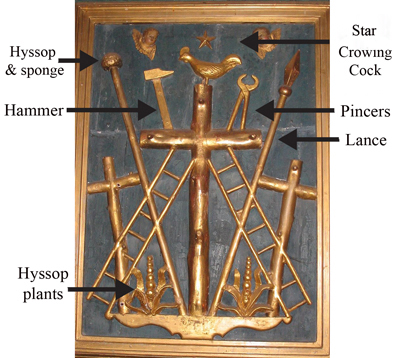 Let us now turn to the second panel of Passion symbols, at right. In this panel, three empty crosses dominate the painting, representing His Crucifixion with the two thieves and Descent, with the large Cross of Christ in the center and the crosses of the good and bad thieves on either side of it.
Let us now turn to the second panel of Passion symbols, at right. In this panel, three empty crosses dominate the painting, representing His Crucifixion with the two thieves and Descent, with the large Cross of Christ in the center and the crosses of the good and bad thieves on either side of it.
At the base of the center Cross, on either side, we observe two hyssop plants growing, referring to St. John's description of the Crucifixion: "Now there was set a vessel full of vinegar: and they filled a sponge with vinegar and put it upon hyssop, and put it to his mouth."(19:29)
A reed with hyssop and a sponge, containing vinegar and gall, is in fact depicted on the left side of the panel, while the pointed lance that pierced Our Lord's Heart is displayed in the right side of the panel.
The ladder, one on each side of the Cross, were used in the Descent. Resting above the arms of the Cross of Christ are two very common symbols: the hammer used to drive the sstakes into Our Lord's innocent Flesh and the pincers used to draw out them out after His Death. Rarely does a manuscript depicting symbols of torture leave these symbols out. Likewise, the cock is almost always present to show the Betrayal of Peter, who denied Christ thrice at night – represented by the star – before the cock crowed, as Christ, oretold.
Having presented these basic criteria, I will offer several more in the next article on the Arma Christi and then invite interested readers to analyze themselves several other Medieval manuscripts portraying Passion symbols.

To be continued


Certainly in the center of Catholic History is the Passion of Our Lord. Accordingly, symbols representing the Agony, the Betrayal, the Arrest, the Trial, the Condemnation, the Crucifixion, the Descent from the Cross and the Burial of Our Lord were very early used in painting and sculpture and universally recognized by the faithful.
Those symbols were given the beautiful name Arma Christi, or Weapons of Christ. They were the Instruments of the Passion, which in heraldry terms became the “arms” of Christ, for these were the weapons Christ used to achieve His conquest over Satan, death and sin.
Instruments of the Passion

A sampling of the most important Passion symbols are set out very neatly in the two pictures above, from the 11th century Église Saint-Pierre in Collonges-la-Rouge. It seemed a good place to start for those interested in learning about the Arma Christi used in both Medieval and Renaissance illustrations and paintings. A recent resurgence of interest in symbols give such explanations special relevance today.
In this first picture above left, we find at at bottom left one of the best known symbols of the Agony, the chalice intended to evoke Christ's Agony in the Garden of Gethsemane. The chalice is called the Cross of Suffering, and is often pictured in manuscripts as a gold cup with precious jewels with a red Cross rising from it, symbolizing the Blood Our Lord sweat in the Garden.

The sword and the rod – when crossed like the letter X – are also well-known symbols of the betrayal. The sword in this depiction of the Arma, however, is most probably the sword of St. Peter, used to sever the ear of Malchus, the servant of the high priest. Very often that severed ear is portrayed with the sword, indicating the Garden scene during Our Lord's arrest.
In the center we find the pillar or column, a key symbol of the trial and condemnation of Our Lord Jesus Christ. It reminds the faithful of the pillar where Our Lord was scourged on the order of Pontius Pilate. Atop the pillar is Veronica's veil, corresponding to the famous episode of Christ imprinting his Sacred Visage on the veil she offered Him as relief from His suffering. Still at the left of the column, we find a scourge (often two scourges in saltire are used) reminding us of His Scourging.
On either side of the Pillar, there is a rod or a reed to depict the mockery Our Savior suffered at the hands of His captors when they buffeted Him. Often a head spitting is painted to depict this offensive action of the brute executioners. The 30 coins of Judas are also displayed in a row here, stressing his iniquitous betrayal.
The vessel, at the bottom right, usually represents the water poured on Pilate’s hands.

The passion flower has many symbols of Christ's Passion
For example, in the picture at left, there are the many hands of the torturers of Christ (e.g. the clenched fist used to buffet Him, the pointing finger that mocks Him); then we have the hand of Peter cutting the ear of Malchus, the hand of the traitor Judas receiving the 30 coins from the hand of the high priest. Often in this kind of scenens are also the hands of Pilate washing them of the Blood of the Savior in a basin that spills the water. Sometimes a white towel used by Pilate to dry his hands is also pictured.
Another panel of symbols

The passion flower has many symbols of Christ's Passion
At the base of the center Cross, on either side, we observe two hyssop plants growing, referring to St. John's description of the Crucifixion: "Now there was set a vessel full of vinegar: and they filled a sponge with vinegar and put it upon hyssop, and put it to his mouth."(19:29)
A reed with hyssop and a sponge, containing vinegar and gall, is in fact depicted on the left side of the panel, while the pointed lance that pierced Our Lord's Heart is displayed in the right side of the panel.
The ladder, one on each side of the Cross, were used in the Descent. Resting above the arms of the Cross of Christ are two very common symbols: the hammer used to drive the sstakes into Our Lord's innocent Flesh and the pincers used to draw out them out after His Death. Rarely does a manuscript depicting symbols of torture leave these symbols out. Likewise, the cock is almost always present to show the Betrayal of Peter, who denied Christ thrice at night – represented by the star – before the cock crowed, as Christ, oretold.
Having presented these basic criteria, I will offer several more in the next article on the Arma Christi and then invite interested readers to analyze themselves several other Medieval manuscripts portraying Passion symbols.

To be continued

Posted April 4,, 2018
______________________
______________________



